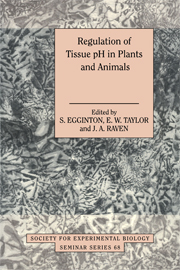Book contents
- Frontmatter
- Contents
- List of contributors
- Preface
- Measurement of intracellular pH: a comparison between ion-sensitive microelectrodes and fluorescent dyes
- pH-sensitive microelectrodes: how to use them in plant cells
- The use of nuclear magnetic resonance for examining pH in living systems
- Invasive studies of intracellular acid–base parameters: quantitative analyses during environmental and functional stress
- Lactate, H+ and ammonia transport and distribution in rainbow trout white muscle after exhaustive exercise
- Limiting factors for acid–base regulation in fish: branchial transfer capacity versus diffusive loss of acid–base relevant ions
- H+-mediated control of ion channels in guard cells of higher plants
- pH regulation of plants with CO2-concentrating mechanisms
- Intracellular pH regulation in plants under anoxia
- The role of turtle shell in acid–base buffering
- Acid–base regulation in crustaceans: the role of bicarbonate ions
- A novel role for the gut of seawater teleosts in acid–base balance
- pH and smooth muscle: regulation and functional effects
- Regulation of pH in vertebrate red blood cells
- Acid–base regulation in hibernation and aestivation
- Hepatic metabolism and pH in starvation and refeeding
- Back to basics: a plea for a fundamental reappraisal of the representation of acidity and basicity in biological solutions
- Index
Preface
Published online by Cambridge University Press: 22 August 2009
- Frontmatter
- Contents
- List of contributors
- Preface
- Measurement of intracellular pH: a comparison between ion-sensitive microelectrodes and fluorescent dyes
- pH-sensitive microelectrodes: how to use them in plant cells
- The use of nuclear magnetic resonance for examining pH in living systems
- Invasive studies of intracellular acid–base parameters: quantitative analyses during environmental and functional stress
- Lactate, H+ and ammonia transport and distribution in rainbow trout white muscle after exhaustive exercise
- Limiting factors for acid–base regulation in fish: branchial transfer capacity versus diffusive loss of acid–base relevant ions
- H+-mediated control of ion channels in guard cells of higher plants
- pH regulation of plants with CO2-concentrating mechanisms
- Intracellular pH regulation in plants under anoxia
- The role of turtle shell in acid–base buffering
- Acid–base regulation in crustaceans: the role of bicarbonate ions
- A novel role for the gut of seawater teleosts in acid–base balance
- pH and smooth muscle: regulation and functional effects
- Regulation of pH in vertebrate red blood cells
- Acid–base regulation in hibernation and aestivation
- Hepatic metabolism and pH in starvation and refeeding
- Back to basics: a plea for a fundamental reappraisal of the representation of acidity and basicity in biological solutions
- Index
Summary
The regulation of [H+] (commonly expressed as pH) in the internal fluids, and consequently in the tissues of living organisms, is central to the processes of homeostatic control. This is because pH determines the charge state on proteins and other macromolecules, which in turn affects vital metabolic processes such as enzyme–substrate binding and the catalytic functions of enzymes. Consideration of pH regulation is, therefore, of fundamental importance to biology. Many factors affect pH, including rates of production, accumulation and excretion of acid metabolites. Regulation of acid–base status involves a number of other physiological processes, most prominently ionoregulation and respiration. Comparative physiologists have been actively working in this area for the last decade, considering new problems of environmental pH variation (e.g. temperature, acid or alkaline waters, availability of ions, respiratory gases or food) and physiological mechanisms (e.g. rates of activity, buffering using skeletal calcium salts, role of the gut, regulation in different tissues and in response to discrete bodily functions such as respiration, digestion or excretion). This volume considers current work by leading plant and animal physiologists, all with international reputations for their work on pH regulation.
Accurate measurement of pH in tissues is complicated by their subdivision into discrete compartments (extracellular fluid volume, intracellular cytosol, tonoplast, nucleoplasm, mitochondria etc.). The small size of these compartments coupled with the highly labile nature of pH variation, which can be critically affected by sampling technique, presents serious technical problems. Initial chapters consider the application of current techniques for measurement of pH in biological systems, the relative merits of which are being hotly debated.
- Type
- Chapter
- Information
- Regulation of Tissue pH in Plants and AnimalsA Reappraisal of Current Techniques, pp. xi - xiiPublisher: Cambridge University PressPrint publication year: 1999



